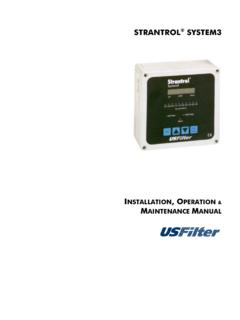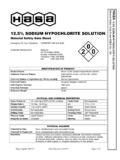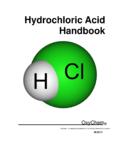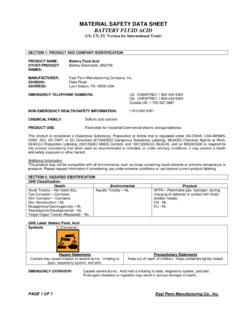Transcription of MURIATIC ACID - Aquatic Specialty Services
1 HASA MURIATIC acid Material Safety Data Sheet MSDS No. 110 Major Update: 08/01/01 Minor Revision: 08/01/02 Page 1 of 4 MURIATIC acid Material Safety Data Sheet Emergency 24 Hour Telephone: CHEMTREC Corporate Headquarters: Hasa Inc. 23119 Drayton Street Saugus, California 91350 Telephone Fax IDENTIFICATION OF PRODUCT Product Name: HASA MURIATIC acid Common Chemical Names: Hydrochloric acid , HCl Chemical Names of Ingredients: Hydrogen Chloride, Water Chemical Family: Inorganic acid CAS Registry Number: 7647-01-0 Empirical Formula: HCl Molecular Weight.
2 [Hydrogen Chloride] PHYSICAL AND CHEMICAL PROPERTIES1 Vapor Pressure: 35 mm Hg at 25 C [77 F] Flash Point: Not Applicable. Weight/Gallon: lbs [ kg] pH: 1% solution less than Density [liquid]: at C [64 F] Odor: Irritating, pungent, acidic Bulk Density: Not Applicable. Boiling Point: 83 C [ F] at 760mm Hg Melting Point: Not Applicable. Freezing Point: -46 C [ F] Physical State: Solution Color: Straw Yellow to water white Solubility in Water: Complete Stability: Stable PHYSICAL HAZARDS Potential for Fire: Nonflammable Potential for Explosion: Forms flammable hydrogen gas on contact with metals. Reactivity: Will react with caustic materials, oxidizing materials and metals [zinc, galvanized iron, brass, aluminum, copper and copper alloys, etc.]
3 ] Hazardous polymerization will not occur. Extinguishing Media: Use water spray or fog nozzle to keep containers cool. Fire Fighting Procedures: Wear self-contained breathing apparatus and protective clothing. HASA MURIATIC acid Material Safety Data Sheet MSDS No. 110 Major Update: 08/01/01 Minor Revision: 08/01/02 Page 2 of 4 HEALTH HAZARDS Signs and Symptoms of Exposure: Eyes and skin burns. Not a skin sensitizer. Medical Conditions Aggravated by Exposure: No data available. Oral [ingestion] LD50: 900 mg/kg2 [rat] Dermal [skin absorption] LD50: No data available. Inhalation [breathing] LC50: 3124 ppm [1 hour, rat]3 Eye Irritation: Corrosive. Will burn eyes on Skin Irritation: Corrosive. Not considered to be a skin OSHA PEL: 5 ppm [ceiling]6 ACGIH TLV/TWA: 5 ppm [as HCl]7 POTENTIAL ROUTE [S] OF ENTRY Inhalation [Breathing]: Inhalation of fumes.
4 Dermal [Skin]: Liquid contact. Eyes: Fumes and/or liquid contact. Ingestion: Swallowing of liquid. Aquatic AND ENVIRONMENTAL TOXICITY 96-hour LC50 [Mosquito Fish]: 282 mg/l8 96-hour LC50 [Blue Gill]: 100% pH lowered to CARCINOGENIC [CANCER POTENTIAL] INFORMATION No evidence of bone, lung, or nasal tumors found in rats chronically exposed to HCl National Toxicological Program [NTP] Sixth Annual Report on Carcinogens: Not listed. International Agency for Research on Cancer [IARC] Monographs, V. 1-53, Supps. 1-8: Not listed. Listed by Federal OSHA as Carcinogens: Not listed. Safe Drinking Water and Toxic Enforcement Act of 1986 [Proposition 65, California only]: Not listed. GENERAL PRECAUTIONS FOR SAFE USE AND HANDLING Store in a cool, dry place.
5 Do not mix with alkaline materials or metals. Keep container closed and protected against physical damage. Separate from incompatible materials in storage areas. Store separated from oxidizers. Keep containers closed when not in use. Keep out of the reach of children. PERSONAL PROTECTION AND HYGIENE Wear rubber gloves and eye protection when handling. Goggles should be vapor proof. Wash hands after handling. Provide ventilation for storage and use areas. Wear impervious clothing when handling and using this product. Do not breathe vapor. Avoid contact with skin and clothing. CLEAN-UP OF SPILLS Neutralize liquid with soda ash, sodium sesquicarbonate, slaked lime, or sodium bicarbonate and flush to a sanitary sewer. HASA MURIATIC acid Material Safety Data Sheet MSDS No.
6 110 Major Update: 08/01/01 Minor Revision: 08/01/02 Page 3 of 4 FIRST AID Eye Contact: Flush with water. Remove contact lenses [if applicable]. Hold eyelids open. Continue flushing with water for 15 minutes. Get prompt medical attention. Skin Contact: Wash affected area with water for 15 minutes. Get medical attention. Ingestion [swallowing]: Drink large quantities of water. DO NOT induce vomiting. Call a physician or poison control center immediately. Inhalation: Move to a safe area. If not breathing, give artificial respiration. Call a physician immediately. FEDERAL/STATE LISTS/REGISTRATION/S/REPORTING REQUIREMENTS CERCLA Hazardous Substance [Section 1010 [4], 96-510]: RQ 5,000 lbs [17,100 gallons based on HCl in solution] Extremely Hazardous Substance [40 CFR 355, Appendix A]: Not listed.
7 Pesticide Product 7 136 et seq.: Not registered. Toxic Substance under TSCA: Yes Pesticide Product [various State Laws]: Not used for pesticidal purposes. Department of Agriculture: GRAS when used in accordance with good manufacturing practices. MATERIAL CLASSIFICATION OSHA Hazard Communication Standard, Department of Labor, Occupational Safety and Health Division, 29 CFR : Corrosive Liquid Department of Transportation CFR 49 Shipping Description: Hydrochloric acid , 8, UN 1789, II [4-1 gallon returnable bottles in plastic crate add DOT-E-6614 after II. ] National Fire Protection Association NFPA 704 [1990]: 3-0-0 BOCA National Fire Prevention Code/National Building Code [1999editions]: Corrosive Liquid Standard Fire Prevention Code/Standard Building Code [1997 editions]: Corrosive Liquid Uniform Fire Code/Uniform Building Code [1997 editions]: Corrosive Liquid Uniform Fire Code Standards 79-3, Uniform Fire Code, V.
8 II [1997 edition]: 3-0-0 HASA MURIATIC acid Material Safety Data Sheet MSDS No. 110 Major Update: 08/01/01 Minor Revision: 08/01/02 Page 4 of 4 FOOTNOTES [REFERENCES] 1 Dupont de Nemours Company, Memo [January 31, 1990] 2 Biochemische Zeitschrift [Berlin, Germany] 134, 437, 23 3 MacEwan, and Vernot, NTIS Pub. No. Ad-AO31860 [1976] [CA 86:13442x][J-2798]: Vernot E. H. et al., Toxicology and Applied Pharmacology, 422 [2]:97-100 [1975]; Wohlsliagel, J. et al., Aerospace Medical Research Laboratories, AMRL-TR-125, pp. 275-285 [1975]; Wohlsliagel, J.
9 Et al., Journal Combustion Toxicology, 3[2]:61-70, [1976]. 4 Griffith, et al, Toxicology and Applied Pharmacology, 55[3]: 501-513 [1081]. 5 Gad, et al., Toxicology and Applied Pharmacology, 84[1]: 93-114. 6 29 CFR 7 ACGIH Bulletin. 8 Wallen, et al., Sewage Industrial Wastes, 29:695 [1957] cited in McKee, et al., Water Quality Criteria. 2nd Edition, 1963. 9 Calms, J. Jr., et al., Proceedings 13th Ind. Wastes Conf., Purdue University Engineering Bulletin, 43:243-252 [1959]. 10 Albert, , et al., Journal National Cancer Institute, 68[4]:597-603 [1982]; Ballou, et al., Pac. Northwest Lab Annu. Re. DOE Asst. Sec. Environ. Report No. PNL-2500-Pt. 1, [1978]: Sellakumar, et al., Proceedings American Association of Cancer Research, 24:94 [1083].
10 Please Note: The information contained herein, while not guaranteed, was prepared by competent technical personnel and is true and accurate to the best of our knowledge and belief. NO WARRANTY OR GUARANTEE, expressed or implied, is made regarding the product performance, product stability, or as to any other condition of use, handling, transportation, and storage. Customer use, handling, transportation, and storage may involve additional safety and/or performance considerations. Our technical personnel will be happy to respond to questions regarding safe handling, storage, transportation and use procedures. The safe handling, storage, transportation and use procedures remain the sole responsibility of the customer.









